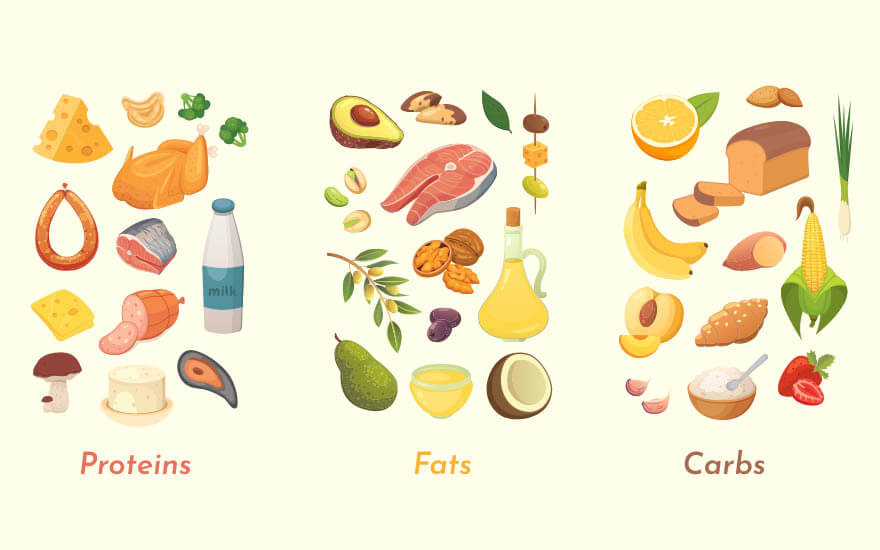In the world of flexible dieting, thousands of athletes and everyday gymgoers use the IIFYM (If It Fits Your Macros) approach. It’s a popular method because it can be easily tailored to help people gain muscle, gain weight, or lose weight, depending on their target.
What is the IIFYM diet?
An IIFYM diet is relatively simple. It’s all about calculating the carbs, fats, and proteins you eat daily. When you gauge your macronutrients correctly, it can be a highly effective way to achieve your physique goals.
The IIFYM diet doesn’t involve calculating the number of calories you ingest. So, if you follow this diet, you won’t need to worry about how many calories you eat. A life free of calorie counting? Interest officially piqued.
What is a macro calculator?
A macro calculator can be found on myriad apps or websites and provides a simple equation to calculate how many macronutrients (carbs, fats, and proteins) your body needs to reach your specific goals.
In a nutshell, a macro calculator eliminates a lot of hard work for you, which is why it’s a prevalent tool in the health and fitness industry.
What are macronutrients?

Macronutrients (macros) refer to carbs, fats, and proteins – the three nutritional components that make up every food source in varying ratios.
When tracking your macros, you need to add up how many grams of each macro you eat each day. This way, you will be armed with the knowledge to achieve your specific dietary goals and targets. It’s that easy.
This approach has been around for a little over 20 years. During this time, it’s helped innumerable people achieve success, from losing weight to staying healthy. Tweaking your balance of all three macros will allow you to determine what your body responds to and catalyze progress according to your physiology and personal goals.
Should I track my macros?
Tracking your macros comes with many advantages as well as a couple of
disadvantages. Although the benefits far outweigh the disadvantages, let’s weigh them up in detail so you can decide for yourself.
Advantages of tracking macros
First, let’s dive into the advantages of tracking your macros.
Advantage 1: Muscle growth

Whether you want to channel Arnie and sculpt a stage-worthy physique or simply increase your muscle mass a little, tracking your macros can be an effectual strategy to help you get there equipped with a greater understanding of your nutritional intake.
For those looking to gain muscle, the standard go-to macro ratio is 40/40/20. With 40% of your food intake coming from protein, 40% from carbs, and 20% from fat. It’s the best place to start for any beginner, then evaluate your results after making subtle switches and reassessing.
If hypertrophy is the aim of your game, you might struggle to pack on the pounds without tracking your macros. Lack of adequate nutrition (protein usually being the main culprit) is why many gym devotees often get confused when they’re lifting weights every day but got gaining enough muscle. Often, it’s because they’re not tracking their diet appropriately, consuming insufficient protein, and not capitalizing on all that hard-earned sweat equity in the weights room.
Advantage 2: Lose fat
Are you trying to lose weight? If so, tracking your macros can help you to declare war on fat and achieve a healthier body fat percentage.
In an age where millions of people have high body fat levels and want to be healthier, it’s not surprising that many are turning to the IIFYM diet. Incorporating this technique can allow users to experience results quickly because their intake of each macronutrient can be tailored to support their weight loss journey.
Reduced fat intake can be a positive driver behind losing weight (due to its higher calorie profile of 9 calories per gram vs 4 calories per gram for carbs and protein). This organically creates a greater calorie deficit, alongside the additional benefit of increased thermogenesis due to higher levels of protein and greater satiability thanks to the fiber content of wholefood-based carbs. Add increased physical activity to this equation and you’re on to a winner.
Many people suffer from weight problems because of a sedentary job, high food intake, and not being physically active. Thankfully, calculating macros can help to counterbalance this and get people moving in the right direction.
Advantage 3: Prevent micronutrient deficiencies
According to research, more than 2 billion people worldwide have micronutrient deficiencies, which equates to around 25% of the population. Unfortunately, many people don’t even realize that they have a micronutrient deficiency – one of the biggest drivers behind health-related problems today.
When you carefully track and calculate your macros and try to ensure they derive from whole food sources, you can eliminate any deficiencies by default. Ensuring you consume a wide variety of vitamins and minerals is excellent for both your short and long-term health and there’s a high chance that you’ll notice improvements in your physical and mental health by making this simple switch. If in doubt, aim to eat the rainbow with your carb allowance.
Advantage 4: Clearly understand what you’re eating
Another significant advantage of tracking your macros is that you gain a much clearer understanding of what you’re eating. Naturally, this makes you more knowledgeable about your diet. In turn, you can then make smarter diet decisions that are aligned with your health and fitness targets.
When you’re in a store, you can buy the food and drinks that you need and analyze the nutritional information on the packaging to know what you’re getting and understand how the macro profile of each item is likely to affect your physique.
Disadvantages of tracking macros
With the advantages covered, let’s briefly examine the disadvantages of tracking your macros.
Disadvantage 1: Time and planning
Due to the nature of macro tracking, it requires a lot of time and planning. As a result, many people struggle to do it. Or they’ll only track their macros for a couple of weeks before losing consistency and motivation.
To be successful, you need to be as consistent and disciplined as possible. It can be hard when balancing a job and personal life, but it is achievable.
Often, it’s a case of finding discipline techniques that work for you. Setting reminders on your phone to eat specific meals and go shopping for food on certain days of the week can help you maintain structure.

In addition, if you’re trying to gain muscle, it might also involve setting reminders for resistance and strength training – you get the idea. Usually, as you become more experienced, you’ll find that tracking your macros becomes a lot easier and you will begin to develop your familiarity with the nutritional profile of your go-to food sources.
Disadvantage 2: Eating disorders
In some cases, macro tracking can encourage disordered eating. Individuals experiencing mental health problems can be especially at risk to being over restrictive, becoming hyper- focused on their macro intake and forming bad habits that lead to a poor relationship with food.
Eventually, if it spirals out of control, then this can lead to the development of an eating disorder. It’s especially prevalent in cases where a person sees quick results, is spurred on, and wants to lose even more weight.
Whilst discipline and consistency are vital to this dieting strategy, everyone is unique and it’s also fundamental to find the right balance and not become unhealthily obsessed with your diet.
How to calculate your macros using a macro calculator
There are several different ways you can calculate your macro intake. In the modern era of fitness, the most popular method is to use a free macro calculator. Over the past decade, the macro calculator has helped countless people with weight loss, muscle gain, body fat percentage levels, and more.
The macronutrient calculator is an essential component to many athletes’ and gymgoers’ regimens, a handy tool to add to the arsenal for anyone from football or basketball players enhancing their athletic performance to a gym bro aboard the gain train.
With a free macro calculator, you’ll receive an estimate of your macronutrient needs based on your:
- Age
- Height
- Current weight
- Activity levels
- Goals (gain weight, lose weight, gain muscle)
Once you calculate this, you’ll be able to create meal plans and purchase the foods needed to achieve your physique ambitions. Usually, most gym disciples will fit their meals in and around their workouts and intense exercise routines.
What quantities of macronutrients should you eat?
The general rule of thumb is to aim for a simple macro calculation in grams per you need to eat per day to gain muscle:
- 2 grams of carbs per pound of body weight – 0.3 grams of fat per pound of body weight
- 1 gram of protein per pound of body weight
A macro calculator provides information surrounding your unique macronutrient needs, customized specifically for you. Sometimes, people use macro meal planning apps to help them do this or work closely with a qualified personal trainer or dietitian to ensure they’re eating the best possible meals.
Do you need to track your macros?
You should now have an idea of how tracking your macros can be very beneficial to support achieving your health and fitness goals, whether that’s to bulk or to cut. Achieving these goals without tracking your macros is entirely possible, however doing so will arm you with the knowledge required to understand what your body responds to and provide a greater comprehension of the foods you’re eating.
Once you learn how to use a macro calculator, you’ll be able to take your overall health and fitness to new heights.





